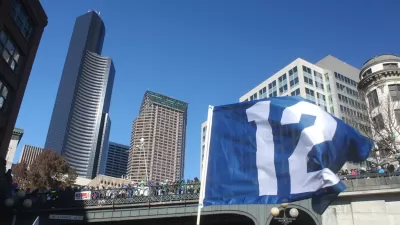A critical component of the landmark and controversial Housing Affordability and Livability Agenda (HALA) platform, announced first in July 2015.

Daniel Beekman writes a critique of the inclusionary zoning policy proposal by the Murray Administration in Seattle. After repeated promises that the city's proposed mandatory inclusionary housing policy would "require market-rate developers to build a minimum number of affordable units in any new construction…"
Beekman throws cold water on that promise, however, reporting that the most recent version of the plan, sent to the City Council by Mayor Ed Murray this week, administration officials "anticipate that 3,700 affordable units would be created through inclusionary housing." Moreover, "they expect that fewer than half of those units — only 1,500 — would be constructed as part of market-rate buildings."
The proposed policy allows developers to pay in lieu fee rather than constructing affordable housing on site. Also, according to Beekman, "developers in South Lake Union and downtown would play by different rules than other developers."
The article gives a detailed account of the evolution of the Housing Affordability and Livability Agenda following its initial, controversial announcement, through the negotiations that produced the in lieu fee of Beekman's current concern. The article is a detailed feature, of interest to anyone looking for more information on the politics and nitty gritty of inclusionary zoning, affordable housing, and development incentives.
FULL STORY: Plan to boost affordable housing in Seattle falls short of mayor’s rhetoric

Maui's Vacation Rental Debate Turns Ugly
Verbal attacks, misinformation campaigns and fistfights plague a high-stakes debate to convert thousands of vacation rentals into long-term housing.

Planetizen Federal Action Tracker
A weekly monitor of how Trump’s orders and actions are impacting planners and planning in America.

San Francisco Suspends Traffic Calming Amidst Record Deaths
Citing “a challenging fiscal landscape,” the city will cease the program on the heels of 42 traffic deaths, including 24 pedestrians.

Defunct Pittsburgh Power Plant to Become Residential Tower
A decommissioned steam heat plant will be redeveloped into almost 100 affordable housing units.

Trump Prompts Restructuring of Transportation Research Board in “Unprecedented Overreach”
The TRB has eliminated more than half of its committees including those focused on climate, equity, and cities.

Amtrak Rolls Out New Orleans to Alabama “Mardi Gras” Train
The new service will operate morning and evening departures between Mobile and New Orleans.
Urban Design for Planners 1: Software Tools
This six-course series explores essential urban design concepts using open source software and equips planners with the tools they need to participate fully in the urban design process.
Planning for Universal Design
Learn the tools for implementing Universal Design in planning regulations.
Heyer Gruel & Associates PA
JM Goldson LLC
Custer County Colorado
City of Camden Redevelopment Agency
City of Astoria
Transportation Research & Education Center (TREC) at Portland State University
Jefferson Parish Government
Camden Redevelopment Agency
City of Claremont




























